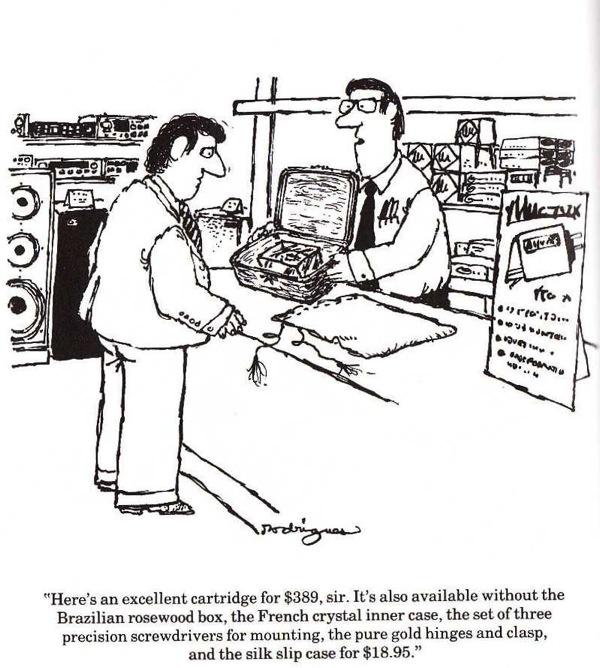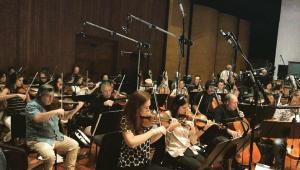I'd argue that you can get 80% of the performance of a pair of $100,000 speakers for a few hundred dollars with a pair of PSB Alpha B1s. Add a properly placed and calibrated subwoofer and you can equal or exceed the performance of any $100K speakers for 1/50th the cost.
What Price Glory

But the cartoon here also heralded a problem that has fallen on the high-end audio industry, a problem also shared, though to a lesser degree, by the home theater business: eye-watering prices. I don’t know the date of the cartoon here, but if you are unfamiliar with the revival of interest in vinyl replay, for example, you can add a zero to the prices in the caption! Assuming the late 1970s, that’s well beyond the inflation rate from then to now.
The audio world is now overloaded with components in the five-figure (the high five figure) price range—not complete systems, but individual components. I even spotted a recent listing on ebay offering a $50,000 pair of speakers. Its tag line was, “Save $40,000.”
Who buys this stuff? Plenty of folks. The planet is big enough (the audio market is worldwide) that folks ranging from the fan living in his parents’ basement and driving a 30 year old VW Beetle (we all have our priorities) to Saudi oil sheiks are standing in line for it.
But the more expensive a product is, the more elaborate its build quality has to be to command its price, since it will sell in quantities that defy mass production. Much of this stuff is hand built, and those thick sheet metal chassis’ and fancy heat sinks, built or ordered by the dozens rather than by the hundreds, greatly inflate manufacturing costs. Suppose for example you put the chassis and engine of a $100,000 Mercedes in VW sheet metal with a VW interior. Could you sell it for half the price? And would people pay $50,000 for it? That’s the sort of question manufacturers in all industries ponder every day.
If you’ve been waiting for the audio system of your dreams and have put aside the money for it, knock yourself out. But know what you’re getting into. There are, for example, $5000/pair speakers that will get you 80% of what the best $100,000/speakers offer, apart from perhaps max SPL capability, fabulously expensive cabinetry, and a cache that will either impress your friends or convince them you’re weird. That last 10% leap toward perfection (you’ll never get beyond 90%!) is always incredibly expensive. And remember, there’s also a 90% guarantee that you’ll want to upgrade in a few years!
The same thing applies to home theater, though it’s likely that visitors will be more impressed by a rocking home theater than by a pricey high-end audio system. Why? Because serious music listening is fast decreasing among the general population. With their iPods, ear buds, and busy lives, they listen to plenty of tunes, but it’s a more casual, on the go pursuit than it once was. Only dedicated enthusiasts sit down and listen to music alone, or with a similarly involved friend or spouse.
But movies are different. They’re often a group experience. Yes, you can now watch films and TV shows on a tablet or (help me, Rhonda) a smart phone, but the paradigm most folks are familiar with, and would like to see in their homes, is the movie theater. The lure of a big screen is hard to resist, and folks are willing to pay for it. And while home theater gear, like high-end audio, can get expensive, there are only a handful of complete 5.1 home theater systems that command prices north of $50,000, and not many more that will run you over $20,000—for both audio and video. That’s big bucks to be sure, but far from six figures. And as with high-end audio, you can get a 5.1-channel system for under $12,000 (or even far less) that will at least approach the best.
Moreover, the video side of home theater has decreased dramatically in price over the past 15 years, and become significantly better as well. In the late 90s, when we were all fretting about Y2K, it took a CRT projector linked to a line doubler or quadrupler, playing back a standard definition DVD, to simulate the theatrical experience. That would run a minimum of $12,000 to the sky’s the limit ($100,000 was not unheard of) for video alone, before you could even think about audio. Today, with HD sources and a digital projector, you can handily exceed that quality, and on a bigger screen, for under $3000. As with high-end audio you can pay more, but only the most dedicated (and flush) enthusiast thinks about spending $20,000 or higher for video—and for that price they demand 4K resolution or it’s no sale.
Both high-end audio or home theater systems can be had at reasonable prices today, though what is reasonable is, as always in the eye and ear (and wallet) of the beholder. But don’t be scared off by the mountainous prices you’ll sometimes see in magazines and on websites. Such gear is often terrific (though not always—while you usually get what you pay for, without research it’s easy to pay too much). But so is more affordable gear.
- Log in or register to post comments

































































